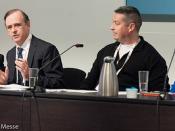This assignment will target an audience of professionals in the field of Childhood Education such as teachers, administrators and aides, as well as those in the field of Communication Sciences and Disorders. In addition, the audience includes scholars and readers of the journal Intervention in School & Clinic: an "Interdisciplinary journal directed to those who deal with the day-to-day aspects of special and remedial education" (Intervention).
As the prevalence of student communication disorders increases, the demand for speech-language pathologists excessively increases also. Many problems come to the minds of teachers when a student shows signs of a communicative disorder, for example, the type and severity of the disorder, the costs of resources, and the availability of those necessary resources. In order to minimize these issues school districts need to implement programs and resources for students suffering from communication disorders within their schools. With these programs, teachers and other school faculty together can learn how to identify student disorders.
This will also help prevent an increase in student disorders and create a positive statistic of student referrals to necessary resources.
Teachers spend the majority of their school day observing their pupils' learning methods and capabilities. Rarely do teachers search for a student's disorder; it merely unfolds when a student shows signs of learning difficulties such as poor behavior, incomplete assignments, and consistent distraction. However, there are assessment and intervention methods provided for teachers, school administrators, and even parents to use when studying a child's learning capabilities. Lisa Sunderland, the director of Special Services in the Kingston, Missouri school district offers communication disorder assessment methods such as hearing screenings, direct observation in classrooms, language sampling and interviews between teachers and students. It is understandable for teachers not to notice a student's disorder initially however, as Sunderland explains, it is far too common...



Very Good.
Very interesting and thought provoking. I really liked this one.
Keep it up.
1 out of 1 people found this comment useful.